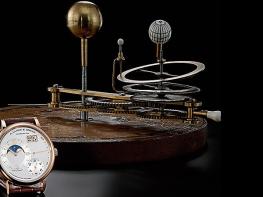The moon, as one of the most prominent celestial bodies, has been preoccupying humankind for millennia. In Saxony, too, the earth’s satellite, its orbital progression, and its influence on various spheres of life intrigued citizens, scholars and regents alike. Augustus, the elector of Saxony, laid the cornerstone for the discipline of astronomy and lunar research in the 16th century. He commissioned Europe’s first large scientific apparatus and instrument collection: the “art chamber” in Dresden was the precursor of the present-day Mathematics and Physics Salon.
The Mathematics and Physics Salon in Dresden owes a very impressive exhibit to the elector’s close ties with William IV, Landgrave of Hesse-Kassel: Eberhard Baldewein’s planetary clock.

The Dresden art chamber encompassed more than 10,000 objects from a wide range of scientific disciplines and occupied seven rooms in the Dresden palace.
Some models in this year’s A. Lange & Söhne collection are dedicated to this fascinating celestial body in a special way.
In the Grand Lange 1 Moon Phase, the earth’s satellite moves into the focus of attention and presents itself in the centre of the hour and minute circle. The patented orbital moon-phase display in the Richard Lange Perpetual Calendar “Terraluna” reproduces the constellation of the moon relative to the Earth and the sun with the utmost precision. The lucid dial layout of the Lange 1 Tourbillon Perpetual Calendar also delivers accurate information about the current phase of the moon.
Click on the large image at the top of the page to view the pictures.




